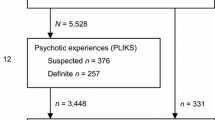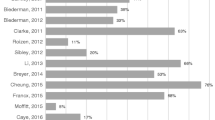Abstract
Little is known about the development and course of depressive symptoms through emerging adulthood among individuals with a childhood history of attention-deficit/hyperactivity disorder (ADHD). The aim of this study was to examine if a history of ADHD in childhood significantly predicted depressive symptoms during emerging adulthood (i.e., ages 18–25 years), including the initial level of depressive symptoms, continued levels of depressive symptoms at each age year, and the rate of change in depressive symptoms over time. 394 participants (205 with ADHD and 189 without ADHD; 348 males and 46 females) drawn from the Pittsburgh ADHD Longitudinal Study (PALS) completed annual self-ratings of depressive symptoms between the ages of 18 and 25 years. Childhood history of ADHD significantly predicted a higher initial level of depressive symptoms at age 18, and higher levels of depressive symptoms at every age year during emerging adulthood. ADHD did not significantly predict the rate of change in depressive symptoms from age 18 to age 25. Childhood history of ADHD remained a significant predictor of initial level of depressive symptoms at age 18 after controlling for comorbid psychiatric diagnoses, but not after controlling for concurrent ADHD symptoms and psychosocial impairment. Participants with childhood histories of ADHD experienced significantly higher levels of depressive symptoms than non-ADHD comparison participants by age 18 and continued to experience higher, although not increasing, levels of depressive symptoms through emerging adulthood. Clinical implications and directions for future research are discussed.

Similar content being viewed by others
References
Angold, A., Costello, E. J., & Erkanli, A. (1999). Comorbidity. Journal of Child Psychology and Psychiatry, and Allied Disciplines, 40, 57–87.
Arnett, J. J. (2000). Emerging adulthood: A theory of development from the late teens through the twenties. American Psychologist, 55, 469–480.
Barkley, R. A., Guevremont, D. C., Anastopoulos, A. D., DuPaul, G. J., & Shelton, T. L. (1993). Driving-related risks and outcomes of attention deficit hyperactivity disorder in adolescents and young adults: A 3- to 5-year follow-up survey. Pediatrics, 92, 212–218.
Barkley, R. A., Fischer, M., Smallish, L., & Fletcher, K. (2006). Young adult outcome of hyperactive children: adaptive functioning in major life activities. Journal of the American Academy of Child and Adolescent Psychiatry, 45(2), 192–202.
Barkley, R. A., Murphy, K. R., & Fischer, M. (2008). ADHD in adults: What the science says. New York: Guilford.
Biederman, J., Mick, E., & Faraone, S. V. (1998). Depression in attention deficit hyperactivity disorder (ADHD) children: “True” depression or demoralization? Journal of Affective Disorders, 47, 113–122.
Browne, M., & Cudeck, R. (1993). Alternative ways of assessing model fit. In K. Bolen & J. Long (Eds.), Testing structural equation models (pp. 136–162). Beverly Hills: Sage.
Chronis-Tuscano, A., Molina, B. S., Pelham, W. E., Applegate, B., Dahlke, A., Overmyer, M., & Lahey, B. B. (2010). Very early predictors of adolescent depression and suicide attempts in children with attention-deficit/hyperactivity disorder. Archives of General Psychiatry, 67, 1044–1051.
Enders, C. K. (2011). Analyzing longitudinal data with missing values. Rehabilitation Psychology, 56, 267–288.
Fabiano, G. A., Pelham, W. E., Jr., Waschbusch, D. A., Gnagy, E. M., Lahey, B. B., Chronis, A. M., . . . Burrows-Maclean, L. (2006). A practical measure of impairment: psychometric properties of the impairment rating scale in samples of children with attention deficit hyperactivity disorder and two school-based samples. Journal of Clinical Child and Adolescent Psychology, 35, 369–385. 10.1207/s15374424jccp3503_3
Flory, K., Molina, B. S., Pelham, W. E., Jr., Gnagy, E., & Smith, B. (2006). Childhood ADHD predicts risky sexual behavior in young adulthood. Journal of Clinical Child and Adolescent Psychology, 35, 571–577. doi:10.1207/s15374424jccp3504_8.
Galambos, N. L., Barker, E. T., & Krahn, H. J. (2006). Depression, self-esteem, and anger in emerging adulthood: Seven-year trajectories. Developmental Psychology, 42, 350–365.
Grant, B. F., & Harford, T. C. (1995). Comorbidity between DSM-IV alcohol use disorders and major depression: Results of a national survey. Drug and Alcohol Dependence, 39, 197–206.
Hoza, B., Gerdes, A. C., Hinshaw, S. P., Arnold, L. E., Pelham, W. E., Jr., Molina, B. S., . . . Wigal, T. (2004). Self-perceptions of competence in children with ADHD and comparison children. Journal of Consulting and Clinical Psychology, 72, 382–391. 10.1037/0022-006X.72.3.382
Hoza, B., Murray-Close, D., Arnold, L. E., Hinshaw, S. P., & Hechtman, L. (2010). Time-dependent changes in positively biased self-perceptions of children with attention-deficit/hyperactivity disorder: A developmental psychopathology perspective. Development and Psychopathology, 22, 375–390. doi:10.1017/S095457941000012X.
Joiner, T. E., Walker, R. L., Pettit, J. W., Perez, M., & Cukrowicz, K. C. (2005). Evidenced-based assessment of depression in adults. Psychological Assessment, 17, 267–277.
Kuo, P. H., Gardner, C. O., Kendler, K. S., & Prescott, C. A. (2006). The temporal relationship of the onsets of alcohol dependence and major depression: Using a genetically informative study design. Psychological Medicine, 36, 1153–1162.
Kuriyan, A. B., Pelham, W. E., Jr., Molina, B. S., Waschbusch, D. A., Gnagy, E. M., Sibley, M. H., . . . Kent, K. M. (2013). Young adult educational and vocational outcomes of children diagnosed with ADHD. Journal of Abnormal Child Psychology, 41, 27–41. 10.1007/s10802-012-9658-z
Lansford, J. E., Erath, S., Yu, T., Pettit, G. S., Dodge, K. A., & Bates, J. E. (2008). The developmental course of illicit substance use from age 12 to 22: Links with depressive, anxiety, and behavior disorders at age 18. Journal of Child Psychology and Psychiatry, 49, 877–885. doi:10.1111/j.1469-7610.2008.01915.x.
Lewinsohn, P. M., Solomon, A., Seeley, J. R., & Zeiss, A. (2000). Clinical implications of “subthreshold” depressive symptoms. Journal of Abnormal Psychology, 109(2), 345–351.
Little, R. J. A. (1988). A test of missing completely at random for multivariate data with missing values. Journal of the American Statistical Association, 83(404), 1198–1202.
Mehta, P. D., & West, S. G. (2000). Putting the individual back into individual growth curves. Psychological Methods, 5, 23–43. doi:10.1037//1082-989x.5.1.23.
Meinzer, M. C., Lewinsohn, P. M., Pettit, J. W., Seeley, J. R., Gau, J. M., Chronis-Tuscano, A., & Waxmonsky, J. G. (2013). Attention-deficit/hyperactivity disorder in adolescence predicts onset of major depressive disorder through early adulthood. Depression and Anxiety, 30, 546–553. doi:10.1002/da.22082.
Meinzer, M. C., Pettit, J. W., & Viswesvaran, C. (2014). The co-occurrence of attention-deficit/hyperactivity disorder and unipolar depression in children and adolescents: A meta-analytic review. Clinical Psychology Review, 34, 569–607.
Molina, B. S. G., Pelham, W. E., Marshal, M. R., Curran, P. J., Gnagy, E. M., Thompson, A. L., & Cheong, J. W. (2007). Developmental influences on the associations among childhood ADHD, antisocial behaviors, and alcohol use. Alcoholism, Clinical and Experimental Research, 31, 285a–285a.
Molina, B. S. G., Hinshaw, S. P., Swanson, J. M., Arnold, L. E., Vitiello, B., Jensen, P. S., . . . Houck, P. R. (2009). The MTA at 8 years: Prospective follow-up of children treated for combined-type ADHD in a multisite study. Journal of the American Academy of Child and Adolescent Psychiatry, 48, 484–500. 10.1097/CHI.0b013e31819c23d0
Molina, B. S. G., Pelham, W. E., Cheong, J., Marshal, M. P., Gnagy, E. M., & Curran, P. J. (2012). Childhood attention-deficit/hyperactivity disorder (ADHD) and growth in adolescent alcohol use: The roles of functional impairments, ADHD symptom persistence, and parental knowledge. Journal of Abnormal Psychology, 121, 922–935. doi:10.1037/a0028260.
Muthen, L. K., & Muthen, B. O. (2010). Mplus User’s guide (6th ed.). Los Angeles: Muthén & Muthén.
Pelham, W. E., & Hoza, B. (1996). Intensive treatment: A summer treatment program for children with ADHD. In E. D. Hibbs & P. S. Jensen (Eds.), Psychosocial treatments for child and adolescent disorders: Empirically based strategies for clinical practice. New York: American Psychological Association.
Pelham, W. E., Gnagy, E. M., Greenslade, K. E., & Milich, R. (1992). Teacher ratings of DSM-III-R symptoms for the disruptive behavior disorders. Journal of the American Academy of Child and Adolescent Psychiatry, 31, 210–218.
Pettit, J. W., Roberts, R. E., Lewinsohn, P. M., Seeley, J. R., & Yaroslavsky, I. (2011). Developmental relations between perceived social support and depressive symptoms through emerging adulthood: Blood is thicker than water. Journal of Family Psychology, 25, 127–136. doi:10.1037/A0022320.
Radloff, L. S. (1977). The CES-D Scale: A self-report depression scale for research in the general population. Applied Psychological Measurement, 1, 385–401.
Safren, S. A., Otto, M. W., Sprich, S., Winett, C. L., Wilens, T. E., & Biederman, J. (2005). Cognitive-behavioral therapy for ADHD in medication-treated adults with continued symptoms. Behaviour Research and Therapy, 43, 831–842.
Safren, S. A., Sprich, S., Mimiaga, M. J., Surman, C., Knouse, L., Groves, M., & Otto, M. W. (2010). Cognitive behavioral therapy vs relaxation with educational support for medication-treated adults with ADHD and persistent symptoms: A randomized controlled trial. Journal of the American Medical Association, 304, 875–880. doi:10.1001/jama.2010.1192.
Sibley, M. H., Pelham, W. E., Molina, B. S., Gnagy, E. M., Waxmonsky, J. G., Waschbusch, D. A., . . . Kuriyan, A. B. (2012). When diagnosing ADHD in young adults emphasize informant reports, DSM items, and impairment. Journal of Consulting and Clinical Psychology, 80, 1052–1061
Sibley, M. H., Pelham, W. E., Derefinko, K. J., Kuriyan, A. B., Sanchez, F., & Graziano, P. A. (2013). A pilot trial of supporting Teens’ academic needs daily (STAND): A parent-adolescent collaborative intervention for ADHD. Journal of Psychopathology and Behavioral Assessment, 35, 436–449. doi:10.1007/s10862-013-9353-6.
Sibley, M. H., Kuriyan, A. B., Evans, S. W., Waxmonsky, J. G., & Smith, B. H. (2014). Pharmacological and psychosocial treatments for adolescents with ADHD: An updated systematic review of the literature. Clinical Psychology Review, 34, 218–232.
Solanto, M. V., Marks, D. J., Wasserstein, J., Mitchell, K., Abikoff, H., Alvir, J. M., & Kofman, M. D. (2010). Efficacy of meta-cognitive therapy for adult ADHD. American Journal of Psychiatry, 167, 958–968. doi:10.1176/appi.ajp.2009.09081123.
Stoolmiller, M., Kim, H. K., & Capaldi, D. M. (2005). The course of depressive symptoms in men from early adolescence to young adulthood: Identifying latent trajectories and early predictors. Journal of Abnormal Psychology, 114, 331–345.
Waxmonsky, J. G., Waschbusch, D. A., Babinski, D. E., Humphrey, H. H., Alfonso, A., Crum, K. I., . . . Pelham, W. E. (2014). Does pharmacological treatment of ADHD in adultsenhance parenting performance? Results of a double-blind randomized trial. Cns Drugs, 28, 665–677.
Wymbs, B., Molina, B., Pelham, W., Cheong, J., Gnagy, E., Belendiuk, K., . . . Waschbusch, D. (2012). Risk of intimate partner violence among young adult males with childhood ADHD. Journal of Attention Disorders, 16, 373–383. 10.1177/1087054710389987
Wigal, T., Brams, M., Gasior, M., Gao, J., Squires, L., Giblin, J., & 316 Study Group. (2010). Randomized, double-blind, placebo-controlled, crossover study of the efficacy and safety of lisdexamfetamine dimesylate in adults with attention-deficit/hyperactivity disorder: novel findings using a simulated adult workplace environment design. Behavioral and Brain Functions, 6, 1–14. doi:10.1186/1744-9081-6-34.
Yaroslavsky, I., Pettit, J. W., Lewinsohn, P. M., Seeley, J. R., & Roberts, R. E. (2013). Heterogeneous trajectories of depressive symptoms: Adolescent predictors and adult outcomes. Journal of Affective Disorders, 148, 391–399. doi:10.1016/j.jad.2012.06.028.
Acknowledgments
This research was principally supported by grants from the National Institute on Alcohol Abuse and Alcoholism (AA011873 and AA00202) and the National Institute on Drug Abuse (DA12414), awarded to Drs. Brooke Molina and William Pelham, funded the Pittsburgh ADHD Longitudinal Study, which was the data source for this project. Additional funding was provided by AA12342, AA00202, MH50467, MH12010, ESO5015, DA016631, MH065899, KAI-118-S1, DA85553, MH077676, MH069614, MH62946, MH065899, MH53554, MH069434, MH099030, IES LO3000665A, IESR324B060045, & NS39087.
In the past three years, Dr. James Waxmonsky served on the advisory panel for Noven Pharmaceuticals and the speaker’s board for Quintiles and received research funding from Janssen Pharmaceuticals. Additionally, Drs. Waxmonsky and Pelham received research funding from Noven Pharmaceuticals.
Conflict of Interest
The authors declare that they have no conflict of interest
Author information
Authors and Affiliations
Corresponding author
Rights and permissions
About this article
Cite this article
Meinzer, M.C., Pettit, J.W., Waxmonsky, J.G. et al. Does Childhood Attention-Deficit/Hyperactivity Disorder (ADHD) Predict Levels of Depressive Symptoms during Emerging Adulthood?. J Abnorm Child Psychol 44, 787–797 (2016). https://doi.org/10.1007/s10802-015-0065-0
Published:
Issue Date:
DOI: https://doi.org/10.1007/s10802-015-0065-0




